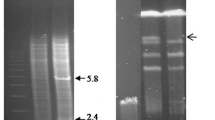Summary
A Tn551 insertional mutation in the accessory gene regulator (agr) locus of the Staphylococcus aureus chromosome resulted in the decreased production of at least seven extracellular toxins and enzymes and a simultaneous increase in the production of protein A and coagulase (Recsei et al. 1986). Adjacent to this locus we have now identified another gene, hld, transcribed into a 0.5 kb RNA which codes for the staphylococcal delta-lysin. The expression of hld, was totally repressed in a strain carrying the agr insertional mutation. Hybridization with strand-specific probes and primer extension analysis revealed that hld, and agr are transcribed in opposite directions, starting 188 nucleotides apart. The hld, gene is mainly expressed during the post-exponential growth phase and is totally repressed during early exponential growth. Determination of hld, mRNA half-life in different growth phases indicated that this regulation is at the level of transcription.
Similar content being viewed by others
References
Arvidson S (1983) Extracellular enzymes from Staphylococcus aureus. In: Easmon CSF, Adlam C (eds) Staphylococci and staphylococcal infections, 2. Academic Press, London, pp 745–808
Björklind A, Arvidson S (1980) Mutants of Staphylococcus aureus affected in the regulation of exoprotein synthesis. FEMS Microbiol Lett 7:203–206
Coleman G, Abbas-Ali B (1977) Comparison of the patterns of increase in alpha-toxin and total extracellular protein formation by a low alpha-toxin-producing variant of Staphylococcus aureus (Wood46) grown in media supporting widely differing growth characteristics. Infect Immun 17:278–281
Das HK, Biro PA, Cohen SN, Ehrlich HA, van Gabain A, Lawrence SK, Lemaux PG, McDevitt OH, Peterlin BM, Schultz M-F, Sood AK, Weissman SM (1983) Use of synthetic oligonucleotide probes complementary to genes for human HLA-DR alpha and beta as extension primers for the isolation of 5′-specific genomic clones. Proc Natl Acad Sci USA 80:1531–1535
Fitton JE, Dell A, Shaw WV (1980) The amino acid sequence of the delta haemolysin of Staphylococcus aureus. FEBS Lett 115:209–212
Graves MC, Rabinowitz JC (1986) In vivo and in vitro transcription of the Clostridium pasteurianum ferredoxin gene. Evidence for “extended” promoter elements in Gram-positive organisms. J Biol Chem 261:11409–11415
Janzon L, Löfdahl S, Arvidson S (1986) Evidence for a coordinate transcriptional control of alpha-toxin and protein A in Staphylococcus aureus. FEMS Microbiol Lett 33:193–198
Lee KY, Birkbeck TH (1984) In vitro synthesis of the delta-lysin of Staphylococcus aureus. Infect Immun 44:434–138
Maniatis T, Fritsch EF, Sambrook J (1982) Molecular cloning. A laboratory manual. Cold Spring Harbor Laboratory, Cold Spring Harbor, New York
Melefors Ö, van Gabain A (1988) Site-specific endonucleolytic cleavage and the regulation of stability of E. coli ompA mRNA. Cell :893–901
Messing J (1983) New M13 vectors for cloning. Methods Enzymol 101:20–78
Michaelis S, Beckwith J (1982) Mechanism of incorporation of cell envelope proteins in Escherichia coli. Annu Rev Microbiol 36:435–465
Morfeldt E, Janzon L, Arvidson S, Löfdahl S (1988) Cloning of a chromosomal locus (exp) which regulates the expression of several exoprotein genes in Staphylococcus aureus. Mol Gen Genet 211:435–440
Novick RP (1967) Properties of a cryptic high frequency transducing phage in Staphylococcus aureus. Virology 33:155–166
Peng H-L, Novick RP, Kreiswirth B, Kornblum J, Schlievert P (1988) Cloning, characterization, and sequencing of an accessory gene regulator (agr) in Staphylococcus aureus. J Bacteriol 170:4365–4372
Recsei P, Kreiswirth B, O'Reilly M, Schlivert R, Gruss A, Novick RP (1986) Regulation of exoprotein gene expression in Staphylococcus aureus by agr. Mol Gen Genet 202:58–61
Sanger F, Nicklen S, Coulson AR (1977) DNA sequencing with chain-terminating inhibitors. Proc Natl Acad Sci USA 74:5463–5467
Author information
Authors and Affiliations
Additional information
Communicated by J. Lengeler
In the paper cloning of a chromosomal locus (exp) which regulates the expression of several exoprotein genes in Staphylococcus aureus (Morfeldt et al. 1988) which appeared in Mol Gen Genet volume 211, we described the cloning of the chromosomal DNA sequences surrounding a Tn551 insertion from a strain WA250. This strain was claimed to be obtained by transduction of the insertion from strain WA205 (derivative of strain V8) to strain 8325-4. Unfortunately, due to misnaming of strains, WA250 has later turned out to be a derivative of 8325-4 obtained by transduction of the insertional agr mutation of strain RN4256 (Recsei et al. 1986) which has a pleiotropic exoprotein deficiency indistinguishable from that of WA205. Consequently the cloned regulatory locus should be referred to as agr
Rights and permissions
About this article
Cite this article
Janzon, L., Löfdahl, S. & Arvidson, S. Identification and nucleotide sequence of the delta-lysin gene, hld, adjacent to the accessory gene regulator (agr) of Staphylococcus aureus . Mol Gen Genet 219, 480–485 (1989). https://doi.org/10.1007/BF00259623
Received:
Issue Date:
DOI: https://doi.org/10.1007/BF00259623




